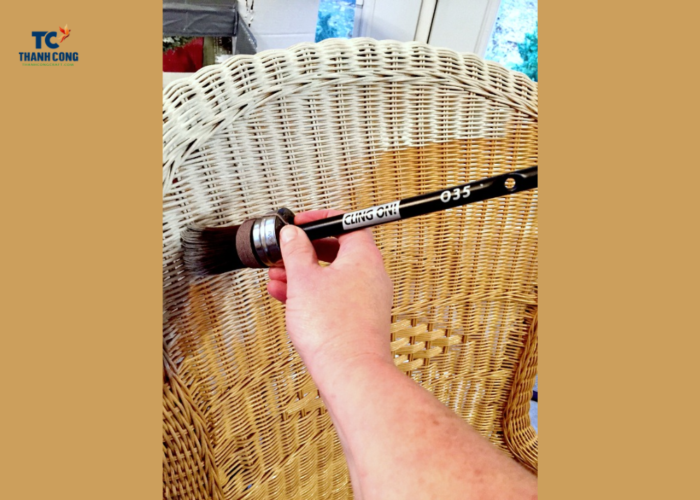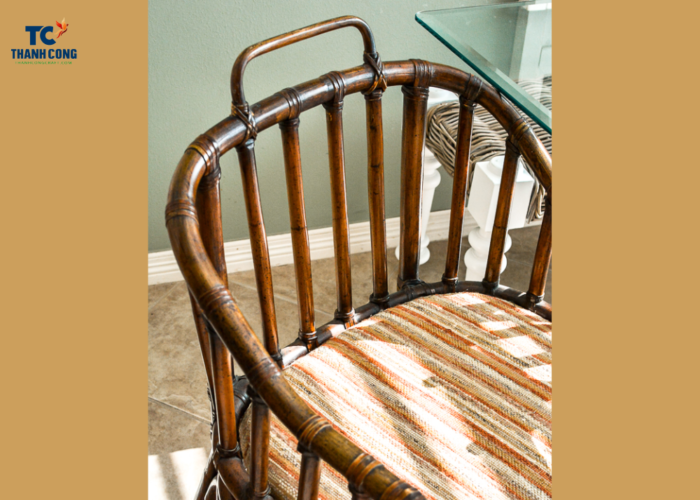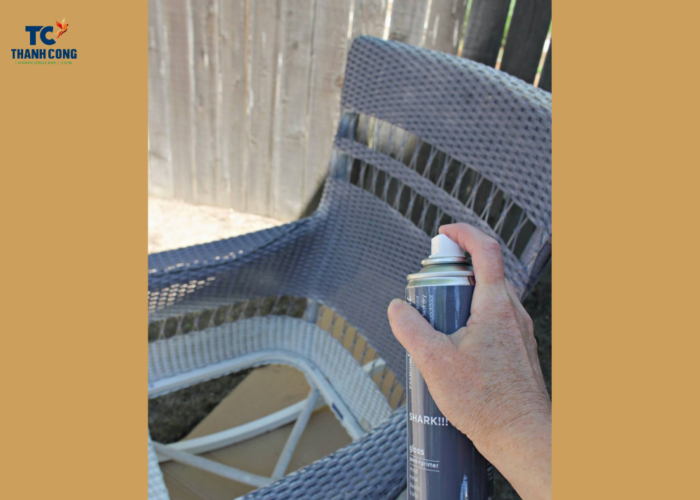Bringing a new burst of color or a fresh coat of paint to your wicker rattan chair can be a transformative project, breathing new life into a piece that may have weathered the test of time. Whether you’re aiming to revitalize your outdoor seating or add a pop of personality to your indoor decor, painting a wicker chair is a satisfying and creative endeavor.
In this guide, we’ll explore the step-by-step process of how to paint a wicker chair/ rattan chair. Let’s explore!
Contents [hide]
1. How do you prepare a wicker chair for painting?
If you’re looking to breathe new life into a wicker chair through painting, proper preparation is key to achieving a stunning and long-lasting finish.
Here’s a step-by-step guide on how to prepare a wicker chair for painting:
- Clean thoroughly: Start by removing any cushions or fabric from the wicker chair. Dust the chair using a soft brush or vacuum cleaner to eliminate loose particles. For more stubborn dirt, mix a mild soap solution and use a sponge to gently scrub the wicker. Allow the chair to dry completely.
- Inspect and repair: Examine the wicker for any signs of damage, loose weaves, or unraveled strands. Repair any structural issues by gluing or securing loose sections. If significant repairs are needed, address them before proceeding to the painting stage.
- Sand the surface: Use a fine-grit sandpaper (around 220 grit) and sand gently to avoid damaging the wicker. Lightly sand the entire surface of the wicker to create a slightly rough texture, which helps the paint adhere better. After sanding, wipe the chair down with a tack cloth or a damp cloth to remove any sanding dust. This ensures a clean surface for painting.
- Protect areas not to be painted: Cover any areas of the chair you do not want to paint, such as metal or decorative elements, using painter’s tape or plastic sheeting.
After completing the preparation steps mentioned above, you are now ready to paint your wicker furniture.

2. Painting a wicker chair methods
Painting a wicker chair is a straightforward process that can breathe new life into your furniture. Here’s 2 methods:
2.1 Spray paint for wicker furniture
Spray paint your wicker chair by maintaining a 20-30 cm distance, applying paint evenly in crevices with horizontal strokes, and allowing 15-minute intervals for two coats. Optimal drying in a shaded, well-ventilated space is crucial.
Detail steps:
Step 1: Clean the wicker chair
Use a brush, damp cloth, or a vacuum cleaner to remove dust from the chair. Let the chair dry completely before painting.
Step 2: Choose the right paint
Opt for spray paint for an even and easy application. Select a color that complements your interior space.

Step 3: Protect the work area
Use plastic sheets or newspapers to cover the floor, walls, or surrounding objects to prevent paint splatter.
Step 4: Paint the wicker chair
Maintain a distance of 20-30 cm between the paint can and the chair when spraying. Apply the paint horizontally from left to right or top to bottom, ensuring even coverage in the chair’s crevices. Spray two coats, with approximately 15 minutes between each coat for drying.
Step 5: Allow the chair to fully dry
Place the chair in a well-ventilated area, avoiding direct sunlight. Drying time may vary from 1-2 hours depending on the type of paint and weather conditions. Once the chair is completely dry, bring it indoors and decorate as desired. Now you have a refreshed and attractive wicker chair!
With these simple steps, you can transform your wicker chair into a new and stylish piece of furniture.
2.2 Painting wicker furniture with a brush
Painting wicker furniture with a brush is a fantastic way to refresh and enhance the beauty of these pieces. To paint wicker furniture, you’ll need to prepare some tools and materials, such as a brush, paint, masking tape, newspapers, paper towels, soap, and water.
Follow these steps:
Step 1: Clean the wicker furniture
Use a damp paper towel with soap and water to gently wipe the wicker, paying attention to crevices and dirt. After cleaning, let it dry completely before painting.
Step 2: Protect the work area
Use newspapers and masking tape to cover surfaces you don’t want to paint. If possible, work outdoors or in a well-ventilated space to avoid inhaling paint fumes.
Step 3: Choose the right paint
Select paint suitable for your wicker furniture. You can use oil-based or water-based paint, depending on the type of wicker and the desired effect. Choose a color that complements your living space.

Step 4: Painting with a brush
Dip a small brush into the paint and gently brush along the vertical fibers of the wicker. Paint from inside out, top to bottom, and left to right to ensure even coverage and no missed spots. Apply at least two coats for the best results, allowing each coat to dry completely.
Step 5: Allow for drying time
After painting, let the furniture dry completely for at least 24 hours before using or moving it. Also, clean your brush and tools after use for future reuse.
By following these steps, you can transform your wicker furniture, giving it a fresh and appealing look.
3. FAQs
3.1 What kind of paint do you use on wicker furniture?
Some common types of paint for wicker furniture include:
- Oil-Based Paint: Oil-based paint offers high durability, excellent moisture resistance, and mold resistance. However, it has a strong odor, dries slowly, and requires solvents for cleaning. It is suitable for natural or synthetic wicker furniture.
- Acrylic Paint: Acrylic paint has good adhesion, dries quickly, and comes in a variety of colors. However, it may have lower durability than oil-based paint and often requires a primer before application. Acrylic paint is suitable for natural or synthetic wicker furniture.
- Spray Paint: Spray paint is convenient, requiring no brushes or rollers, and can create textured or glossy finishes. However, it tends to be more expensive, challenging to control the amount of paint, and can have environmental implications. Spray paint is suitable for synthetic wicker furniture.
Each type of paint has its advantages and considerations, so choosing the right one depends on your preferences, the type of wicker furniture, and the desired outcome.
3.2 Is it better to spray paint or brush paint wicker furniture?
Choosing between spray painting and brush painting for wicker furniture involves considering various factors. Spray painting offers convenience with its ease of application, especially on intricate wicker patterns, providing a smooth finish without visible brush strokes. However, it comes with potential environmental impact and higher costs for quality spray paint and equipment.
On the other hand, brush painting provides better control over the paint application and is more cost-effective, making it suitable for detailed work. However, it may leave visible brush strokes on the wicker surface, and the process can be time-consuming, particularly for intricate designs.
In conclusion, the decision hinges on personal preferences, the specific wicker furniture piece, and the desired outcome. If a quick and smooth finish is the priority, spray painting might be the preferred option. Alternatively, if control and cost-effectiveness are key, brush painting could be the suitable choice, even if it requires a bit more time and attention.
3.3 How many cans of spray paint do I need for a wicker chair?
The number of spray paint cans needed for a wicker chair depends on several factors, including the size of the chair, the intricacy of the wicker pattern, and the coverage capability of the spray paint. As a general guideline, one to two cans of spray paint may be sufficient for a standard-sized wicker chair with a simple design.
For larger chairs or those with intricate patterns that require more detailed coverage, you may need additional cans. It’s advisable to check the coverage information provided on the spray paint cans, as this will give you an estimate of how much area each can cover.
To ensure a consistent and even finish, it’s always a good idea to buy slightly more spray paint than you estimate needing. This way, you can avoid running out mid-project and achieve a satisfactory result with the desired color and coverage.
4. Final thought
Your efforts have not only revived a piece of furniture but also allowed you to express your creativity. The vibrant hues or subtle tones you’ve chosen now infuse personality into your space, making your wicker chair a statement piece.
Enjoy the revamped beauty and newfound charm your painted wicker chair brings to your living space!
If you have any further questions, don’t hesitate to send thanhcongcraft an email us at info@thanhcongcraft.com or message us at WhatsApp: +84967485411. Hope to serve you soon! Best regard!


